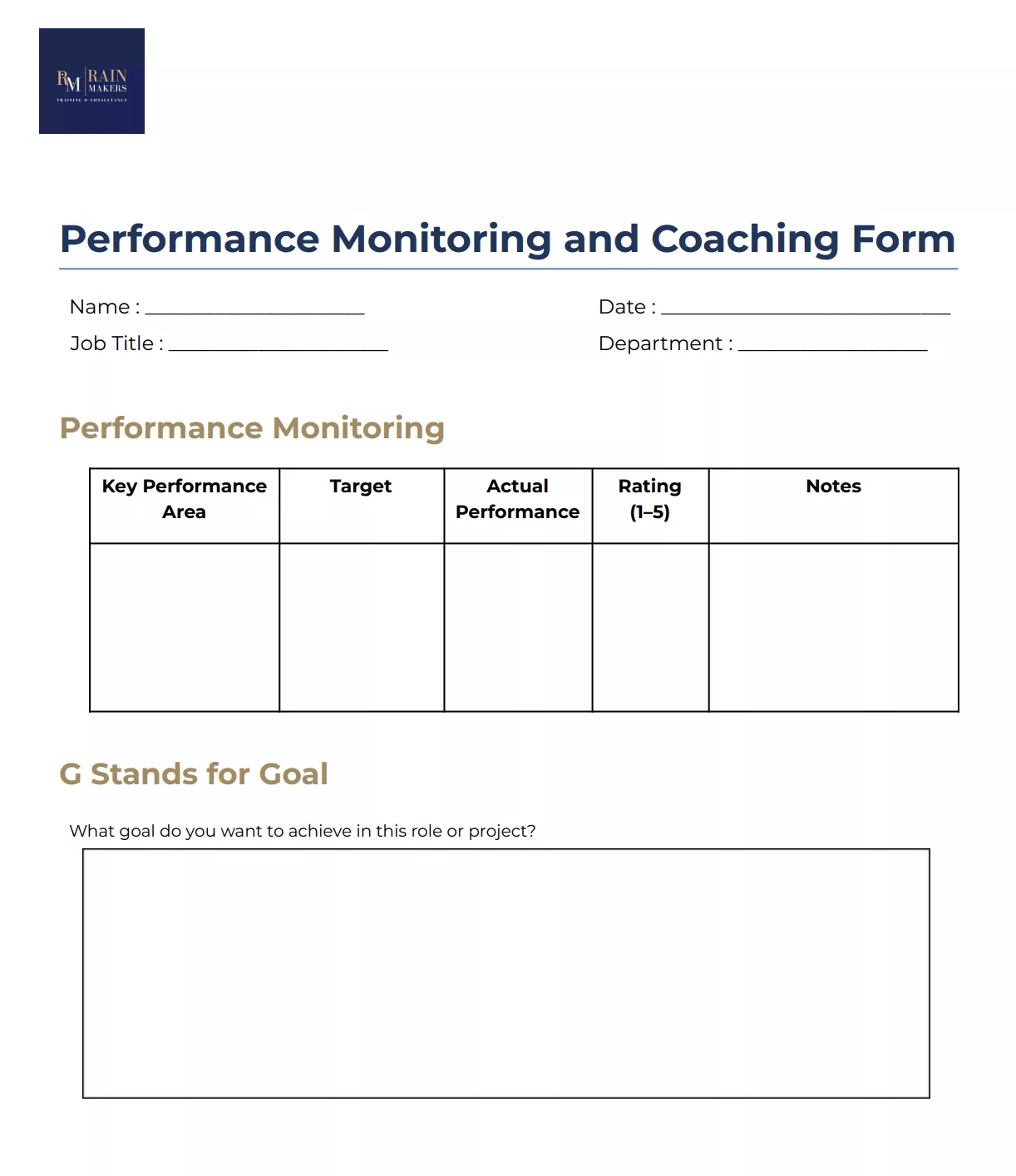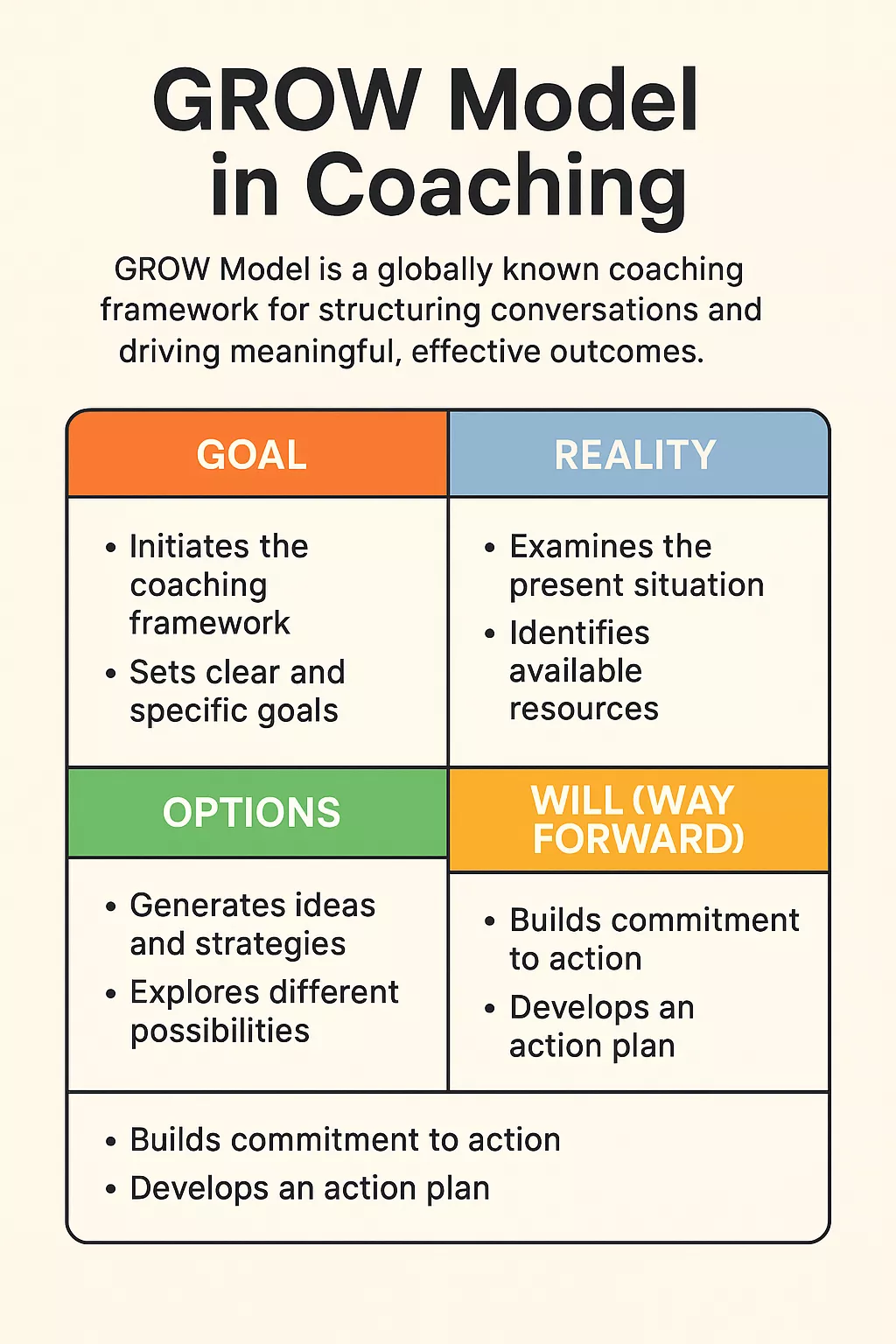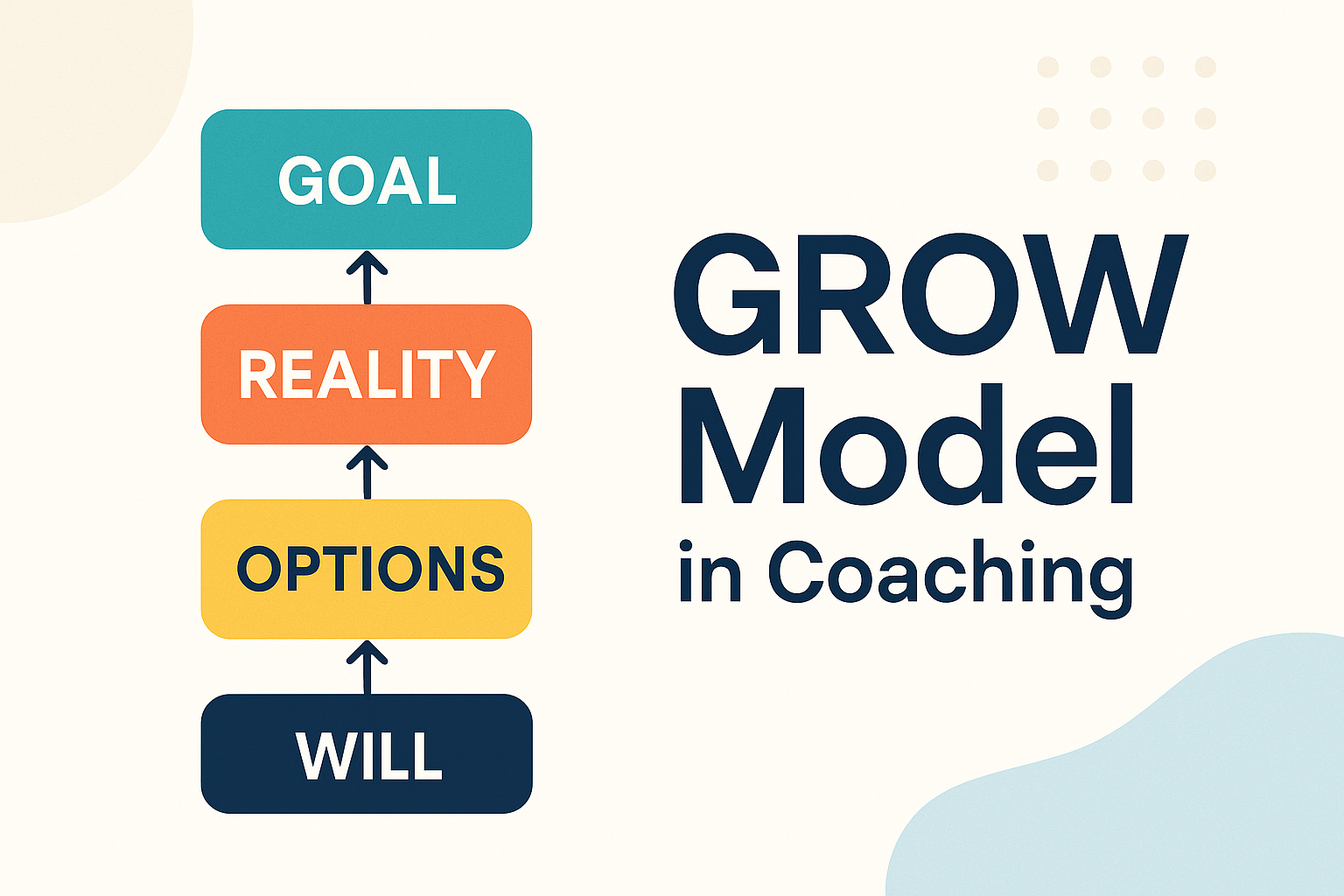Performance Monitoring and Coaching Form [Free Printable Template]
Performance monitoring and coaching form is a structured tool for helping organizational leaders track and measure performance to guide their teams through practical coaching sessions.
This form combines two essential practices: performance monitoring (which measures actual results vs. target performance) and coaching (which develops employees through effective, structured conversations).
 Core Pillars of the Performance Monitoring and Coaching Form
Core Pillars of the Performance Monitoring and Coaching Form
1. Employee Information
Like any form, the first section of the performance monitoring and coaching form collects the basic details of the employee (name, role or job title, department or team, and date when the coaching session takes place).
These details may be too simple, but serve the actual purpose of:
- Accountability - by jotting down info, your firm owns the entire performance and coaching discussion. The leader/manager and employees know what progress is tracked, when, and why.
- Traceability - the beauty of dates and actual role information is that you can store and review them later, which makes it easier to follow through and compare actual results across different time periods, or simply look back at previous coaching sessions.
- Context - depending on the job role and department, it's different from one department to another. So, let's say the goals of a sales officer are quite different from those of an operations supervisor. Knowing this context avoids any misaligned coaching sessions.
2. Performance Monitoring
The next section of this form helps measure how well an employee performs regarding his or her agreed-upon targets. It normally includes a table where the manager and subordinate can record specific elements:
- Key Performance Areas - include the main responsibilities and focus areas of the role (e.g., CSAT score, sales target, etc.).
- Target - expected outcome that was set for that KPA.
- Actual Performance - the result that was actually achieved within the time period of review.
- Rating (1-5) - a scale to assess whether the performance met expectations (i.e., 1 = needs improvement or 5 = exceeded expectations).
- Notes – input your observations, clarifications, or any specific examples
The performance monitoring section covers three purposes:
- Objective Measurement - if you document targets and actual results, it makes your coaching more objective in managing performance. You see facts clearly.
- Foundation for Coaching - the data you collected sets a good atmosphere for your coaching conversation. You guide the discussion around specific goals, targets, achievements, or gaps.
- Progress Tracking - having several forms will help you compare and show trends in employee performance - making your coaching efforts more measurable and impactful.
3. GROW Coaching Framework
This is the meat part of the performance monitoring and coaching form, as we use the globally renowned coaching framework, the GROW model, which you and I will maximize to structure coaching conversations.
The form is divided into four core parts:
G – Goal
This is the stage where you clarify what your subordinate or specific employee wants to achieve. Goals vary depending on the performance targets, career objectives, or broader career aspirations.
Some guiding questions may include:
- What is the specific target, or measurable goal, you want to achieve?
- What would success look like for you in this job role?
- How can this particular goal link to your current job responsibilities or the objectives in our company?
The main purpose of the Goal stage is to help both the manager (coach) and associate (coachee) to align their expectations and outcomes - creating their own shared definition of success.
R – Reality
This stage assesses your employee's current situation (reality) in relation to his or her desired goal or target. It will uncover any assumptions, gaps, or obstacles that might be preventing his or her progress.
Guiding questions may include:
- Where are you right now in relation to your goal?
- What challenges or roadblocks are you experiencing?
- What have you tried, and what results did you get?
- What strengths can you leverage to move closer to your goal or target?
The purpose of the Reality section is to build the right awareness of your coachee's present stage or reality. By contrasting reality with the actual goal, your coachees can see the necessary changes and recognize more of their strengths and blind spots.
O – Options
This stage is where you help coachees generate possible strategies to move closer to their goals. Instead of focusing only on the problems, you shift the discussion to opportunities and alternatives that will improve their performance.
Guiding questions include:
- What different strategies and approaches could you take to reach your goal?
- What resources, support, or tools are available to you?
- What else would you try if there were no constraints (or barriers towards achieving your goals)?
- Which of these options is more reliable, feasible, and inspiring?
The Options stage aims to inspire and encourage creativity and create ownership.
W – Way Forward (Will Do)
In this stage, you translate insights and strategies into specific action steps - where you really need to establish accountability.
Guiding questions include:
- What exact steps or actions will you take moving forward?
- When and how will you measure progress?
- What support or resources do you need from me, the team, or the company?
- How will you hold yourself accountable for all these actions?
The Way Forward stage aims to conclude your coaching conversations into actions - leaving your coachee with clear steps, timelines, and responsibilities.
GROW Model in Coaching
GROW Model is a globally known coaching framework for structuring conversations and driving meaningful, effective outcomes.
First developed by Sir John Whitmore and his colleagues in the 1980s, it has been used to simplify the entire coaching process and is now a recognized coaching framework in leadership, sports, and 1-to-1 coaching.
Why the GROW Model Framework Matters in Coaching?
For many, coaching seems to be a daunting word in leadership; others are confused about what, why, and how to coach. That gives us the primary reason why the GROW Model has gone mainstream: It makes coaching and mentoring a lot easier for leaders to structure conversations and focus more on the person being coached.
The GROW Model enables leaders to assist their people in reflecting and finding their own answers from their own experiences instead of merely pushing solutions or plainly giving advice on what to do next.
Here are a couple more reasons why the GROW model has become a popular framework in coaching:
Benefits for leaders, managers, and coaches
It is easy to get stuck with developing your people and end up micromanaging them if you don't have clarity on how to coach them in the first place. Having the GROW Model as a starting framework will help you ask the right questions and draw out timely insights relevant to their current context so you can support them in creating their own solutions. The GROW model helps you stay purposeful and outcome-driven in your coaching conversations.
Builds clarity and accountability
When leaders are clear about what to do and what framework to use, it's easier for them to take action. Moving from the Goals discussion to Will or Way has helped many leaders coach their people on what they want to achieve and what actions to take - closing the gap between their goals and their reality.
The GROW Model coaching can also help leverage structure to build accountability, given that the coachee can identify exactly the next steps (or action plan) and commit to taking them.
Encourages self-discovery
With the GROW Model, it's easier to ask questions that elicit self-reflection on the part of the coachee. Thus, helping him or her go deeper in learning has a lasting impact on behavioral change. When a coachee understands the deeper reason (why) and decides based on what he or she thinks are the best courses of action, they are more likely to commit to these actions if they identify them themselves.
Adaptable across industries
The beauty of the GROW Model is that it can be applied in almost any context—whether in the government sector or private (business coaching) environment. For instance, it can help improve individual performance to achieve necessary KPIs in business. In sports, it can help sharpen athletes' focus. For personal coaching, it can serve as a support system for individuals to actually reach their personal and career goals.
Breakdown of the GROW Model
The GROW Model is primarily built on four stages: Goal, Reality, Options, and Will or Way. Each of these stages plays a crucial role in the entire coaching conversation.
 1. Goal
1. Goal
Goal initiates the GROW coaching framework, which helps leaders set clear and specific goals. Without any defined destination, conversations can spiral—confused, vague, and unproductive. Having the first step—goal—can help your coachee set a measurable process to track in the first place.
Here are a few tips to help you set goals:
- Use SMART as a benchmark in setting goals (Specific, Measurable, Achievable, Relevant, Time-bound).
- Align goals with the vision. The goal must fit into the bigger picture of the coachee's life and career.
- Outcome focus (let every goal clarify what success looks like or be set by the coachee).
2. Reality
Once you've helped the coachee clarify goals, the next step is to let him or her reflect on and understand the current Reality. This process now involves examining the present situation, identifying any barriers to success, and recognizing any available resources at hand.
Face reality, and the action plan becomes more feasible. Being honest about assessing the current situation helps goals become more granular, and it can be helpful to see if any gaps need to be addressed before moving forward with the conversation.
When helping the coachee with understanding the Reality, consider the following:
- Current and available resources (skills, support system, tools, technology, team members, etc).
- Obstacles (personal and organizational challenges, workload, knowledge, and skills gaps).
- Mindset check (beliefs, behavioral changes, and attitudes that can help or may hinder progress).
3. Options
After setting goals and clarifying reality, the next step is to explore options. At this stage, you are free to generate ideas, strategies, and solutions—basically, you are looking at different possibilities.
Instead of spending hours thinking of the perfect solution, help the coachee use creativity to list options and then later narrow them down (the next step of the coaching process).
The best part is that when individuals and leaders come up with their own solutions, they become more accountable and feel ownership of the solution.
When diving into options, consider these things:
- Pros and cons analysis of different choices identified
- Innovative solutions that go beyond the obvious.
- Support systems such as other coaches, mentors, tools, or colleagues who can assist
4. Will (Way Forward)
The final stage of the GROW Model framework is helping the coachee commit to action - Will or Way Forward.
At this stage, you have to help the individual decide what to do, when to do it, and how to stay consistent and accountable to take the necessary actions. Without this step, your goal remains unexecuted.
So, having the commitment in place after identifying options will help the entire coaching process lead to real behavioral change and create measurable progress towards achieving goals.
Integrate these elements into this stage of coaching conversations:
- Action plan (clear steps to move towards the goal set).
- Timeline (specific deadlines for each action or step)
- Review process (when and where to have regular check-ins to track progress).
- Responsibility (be clear on who is accountable for what).
Example Questions Using the GROW Model
Now, it's easy to have this framework in mind, but having a set of templated questions to initiate every stage of the GROW Model framework can help you, as the leader or manager, set the tone of the conversation and arrive at a desired outcome yourself.
Goal Questions
- What do you want to achieve in this session?
- What would success look like for you in the next 3 months?
- How will you know when you have reached your goal?
Reality Questions
- What is happening right now that affects this goal?
- What steps have you already tried?
- What obstacles are standing in your way?
- What resources do you currently have that can help?
Options Questions
- What possible strategies can you think of?
- What else could you try if your first plan does not work?
- Who could support you in achieving this?
- If you had no limitations, what would you do?
Will (Way Forward) Questions
- What specific action will you take first?
- When will you take this step?
- What might stop you from doing it, and how will you overcome that?
- How will you keep yourself accountable?
Frequently Unasked Questions
Can the GROW Model be used outside coaching (e.g., self-reflection)?
While the GROW model is primarily designed for coaching conversations, it can also be applied to self-coaching or as a self-reflection tool.
Individuals, not just leaders, can use the GROW Model framework to set personal goals, reflect on their current reality, consider useful options, and commit to a set of actions to achieve their goals.
How does it differ from other coaching models (e.g., CLEAR, OSKAR)?
The GROW framework is very goal-driven and follows a systematic, logical sequence from defining goals to committing to actions. Other coaching frameworks, like CLEAR (Contracting, Listening, Exploring, Action, Review), highlight the relationship process and are more often flexible in the flow of conversations.
Other coaching models like OSKAR (outcome, scaling, know-how, affirm/action, review) are heavy on solutions and are more popular in workplace coaching setups.


